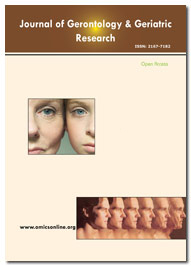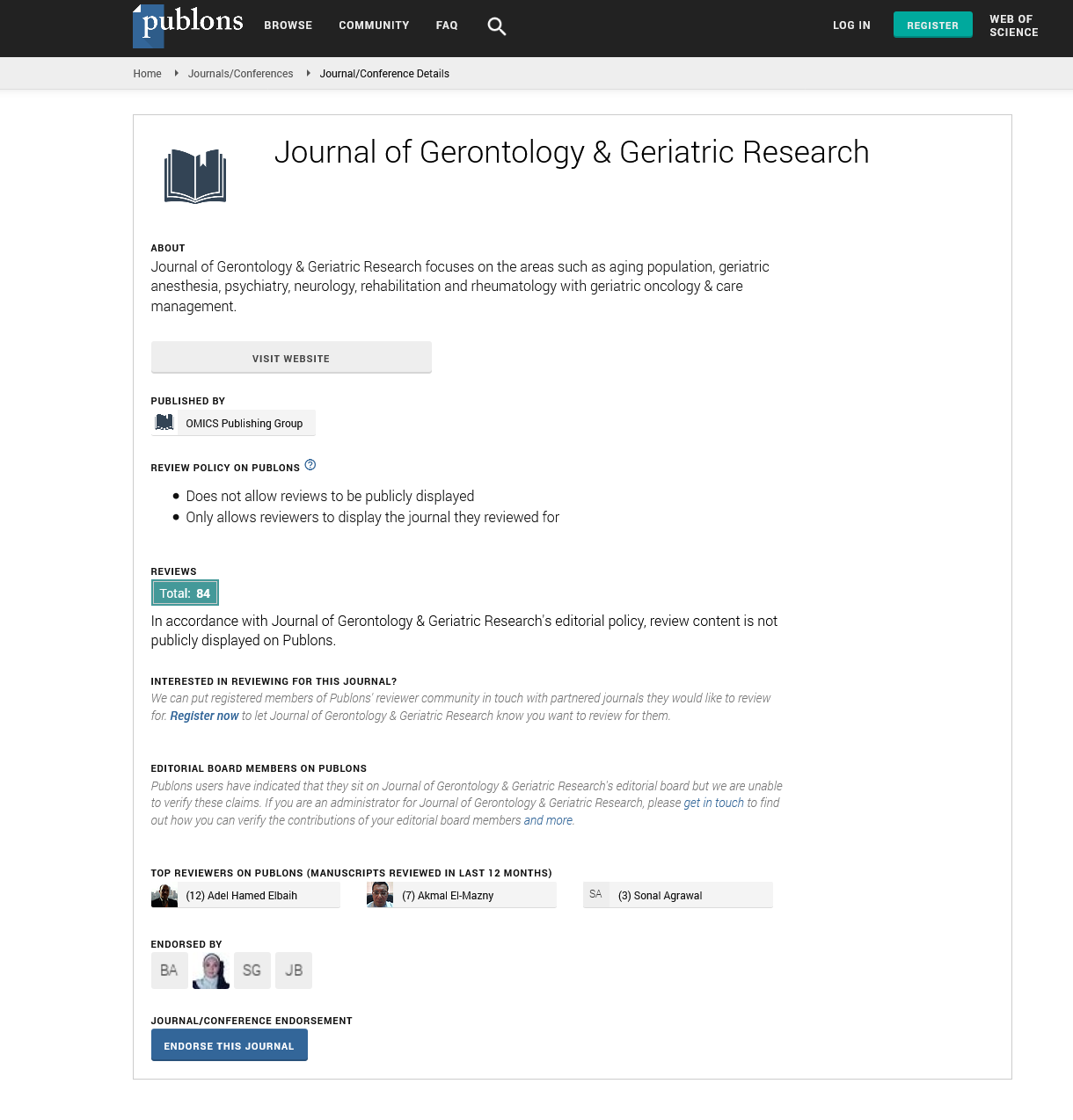Indexed In
- Open J Gate
- Genamics JournalSeek
- SafetyLit
- RefSeek
- Hamdard University
- EBSCO A-Z
- OCLC- WorldCat
- Publons
- Geneva Foundation for Medical Education and Research
- Euro Pub
- Google Scholar
Useful Links
Share This Page
Journal Flyer

Open Access Journals
- Agri and Aquaculture
- Biochemistry
- Bioinformatics & Systems Biology
- Business & Management
- Chemistry
- Clinical Sciences
- Engineering
- Food & Nutrition
- General Science
- Genetics & Molecular Biology
- Immunology & Microbiology
- Medical Sciences
- Neuroscience & Psychology
- Nursing & Health Care
- Pharmaceutical Sciences
Commentary - (2024) Volume 13, Issue 6
Revolutionizing Alzheimerâs Detection: The Role of Genetic and Epigenetic Marker
Joyce Abaza**Received: 04-Dec-2024, Manuscript No. jggr-25-28290; Editor assigned: 06-Dec-2024, Pre QC No. P-28290; Reviewed: 18-Dec-2024, QC No. Q-28290; Revised: 24-Dec-2024, Manuscript No. R-28290; Published: 31-Dec-2024, DOI: 10.35248/2167-7182.2024.13.764
INTRODUCTION
Alzheimer's disease, a progressive neurodegenerative disorder, poses a significant global health challenge. As the population ages, the incidence of Alzheimer's disease continues to rise, placing an increasing burden on healthcare systems and families. One of the key challenges in managing Alzheimer's disease is its late-stage diagnosis, often after irreversible cognitive decline has occurred. However, recent years have witnessed remarkable advancements in the early detection and diagnosis of Alzheimer's disease, offering hope for timely interventions and improved patient outcomes. This article explores the latest innovations and breakthroughs that are transforming our approach to identifying Alzheimer's disease at its earliest stages [1]. Alzheimer's disease is characterized by the accumulation of abnormal protein aggregates, such as beta-amyloid plaques and tau tangles, in the brain. These pathological changes lead to cognitive impairments, memory loss, and ultimately, the loss of independence. While there is currently no cure for Alzheimer's disease, early detection allows for interventions that can slow down the progression of symptoms and improve the patient's quality of life. Individuals diagnosed at an early stage can participate in clinical trials aimed at testing new therapies. This is essential for advancing our understanding of the disease and developing effective treatments. Early diagnosis provides individuals and their families with the opportunity to plan for the future, make informed decisions about care, and access appropriate support services.
DESCRIPTION
The rapid advancements in machine learning and Artificial Intelligence (AI) have opened up new possibilities for early Alzheimer's disease detection. These technologies can analyse complex datasets to identify patterns and subtle changes that might not be apparent to human clinicians. Some applications of AI in this context include: Machine learning algorithms can analyse brain imaging data to detect subtle patterns associated with Alzheimer's disease. These algorithms can learn from large datasets and improve their accuracy over time. AI models can integrate various biomarker data to predict an individual's risk of developing Alzheimer's disease. These models take into account factors such as genetics, biomarker levels, and cognitive assessments. With the widespread use of smartphones and wearable devices, researchers are exploring the potential of digital biomarkers, such as typing patterns, voice changes, and gait analysis, to detect early cognitive changes that might be indicative of Alzheimer's disease [2]. Genetics plays a significant role in Alzheimer's disease risk. While the APOE ε4 allele is a well-known genetic risk factor, recent studies have identified several other genetic variants associated with increased susceptibility to the disease. Advances in genetic testing and analysis have enabled researchers to assess an individual's genetic risk profile for Alzheimer's disease. Polygenic risk scores consider multiple genetic variants to provide a comprehensive assessment of an individual's genetic risk for Alzheimer's disease. These scores, combined with other biomarker data, contribute to a more accurate prediction of disease risk. Studying families with a history of early-onset Alzheimer's disease has led to the identification of rare genetic mutations that directly cause the disease. Understanding the mechanisms behind these mutations offers insights into potential therapeutic targets [3]. Technological advancements have the potential to revolutionize the ageing experience. From telehealth services and wearable devices to assistive technologies and smart homes, technology offers innovative solutions to address the challenges faced by older adults. Exploring the integration of technology into ageing research and healthcare can improve access to services, enhance independence, and support healthy ageing [4]. False Positives and Negatives: Biomarker-based approaches may yield false positive results, causing unnecessary anxiety for individuals without the disease, or false negatives, delaying appropriate interventions. Ethical issues arise when using predictive genetic testing for Alzheimer's disease risk. Providing individuals with accurate information and ensuring informed consent are essential. As digital biomarkers and AI-driven diagnostics become more prevalent, ensuring the privacy and security of sensitive health data becomes paramount. Early diagnosis is meaningful only if it leads to effective interventions. Ensuring equitable access to quality care and treatment options is crucial [5]. The advancements in the early detection and diagnosis of Alzheimer's disease offer a glimmer of hope for addressing the global challenge posed by this devastating condition. The integration of biomarkers, AI, genetics, and digital health technologies holds the potential to revolutionize our approach to Alzheimer's disease management. However, translating these advancements into clinical practice requires interdisciplinary collaboration, rigorous validation, and addressing the ethical and social implications of early detection. As research continues to unveil the intricate mechanisms underlying Alzheimer's disease, the medical community inches closer to a future where interventions can be tailored to an individual's specific risk profile and disease stage. Ultimately, the goal is to shift the focus from latestage palliative care to proactive, personalized strategies that improve the quality of life for those at risk of or already affected by Alzheimer's disease. The journey toward early detection and intervention may be complex, but it is one that holds the promise of brighter outcomes for countless individuals and their families.
CONCLUSION
Advancements in the early detection and diagnosis of Alzheimer's disease are transforming our understanding of this intricate condition, offering new pathways for intervention and support. The integration of cutting-edge technologies such as biomarker analysis, artificial intelligence, genetics, and digital health tools is driving us toward a future where Alzheimer's can be identified and managed in its earliest stages. This progress has the potential to enhance patient outcomes and reduce the strain on healthcare systems and families worldwide. As we continue to make strides, it is important to maintain a balanced view of both the opportunities and challenges tied to early detection. While the research landscape is filled with optimism and potential, it is essential to address ethical concerns, data privacy issues, and disparities in access to care. Collaborative efforts among researchers, healthcare providers, policymakers, and patient advocacy groups are crucial in overcoming these challenges and ensuring that the benefits of early detection reach all members of society.
REFERENCES
1. Tible OP, Riese F, Savaskan E, Von Gunten A. Best practice in the management of behavioural and psychological symptoms of dementia. Ther Adv Neurol Disord 2017; 10:297-309.
2. Vaingankar JA, Chong SA, Abdin E, Picco L, Jeyagurunathan A, Seow E, et al. Behavioral and psychological symptoms of dementia: prevalence, symptom groups and their correlates in community-based older adults with dementia in Singapore. Int Psychogeriatr 201; 29:1363-76
Citation: Abaza J (2024) Revolutionizing Alzheimer’s Detection: The Role of Genetic and Epigenetic Marker. J Gerontol Geriatr Res. 13: 764.
Copyright: © 2024 Abaza J. This is an open-access article distributed under the terms of the Creative Commons Attribution License, which permits unrestricted use, distribution, and reproduction in any medium, provided the original author and source are credited.

